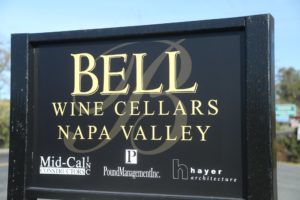
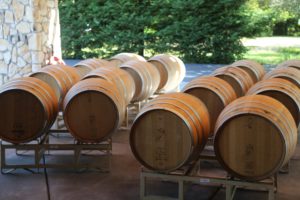
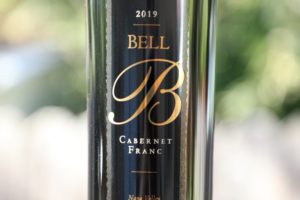 Bell Wine Cellars is located off of Washington Street, just south of Yountville about 3/4 of a mile from Highway 29. Despite the Yountville town address, the winery sits in the country surrounded by vineyards and the nearby riparian zone of the Napa River. During unseasonably heavy rainfall years, sometimes the water overflows its banks and the nearby vineyards will flood. Two nearby winery neighbors include the former Mira Winery now owned by Colgin Cellars and Hoopes Vineyard (formerly Hopper Creek Winery).
Bell Wine Cellars is located off of Washington Street, just south of Yountville about 3/4 of a mile from Highway 29. Despite the Yountville town address, the winery sits in the country surrounded by vineyards and the nearby riparian zone of the Napa River. During unseasonably heavy rainfall years, sometimes the water overflows its banks and the nearby vineyards will flood. Two nearby winery neighbors include the former Mira Winery now owned by Colgin Cellars and Hoopes Vineyard (formerly Hopper Creek Winery).
Winemaker and founder of Bell Wine Cellars, Anthony Bell was born and raised in Stellenbosch in South Africa where his father ran the Gilbey’s operations, a spirit’s company – which was known for their gin but also produced a cream sherry fortified wine. Anthony has been attracted to agriculture since his youth; before coming to Napa Valley in 1977 he worked at wineries in various wine regions in Europe and in South Africa. He graduated from Stellenbosch University in South Africa with an undergraduate degree in viticulture and later earned his master’s degree in enology from U.C. Davis.
Anthony worked for 15 years at Beaulieu Vineyard as director of wine making and later as General Manager. He worked alongside prominent wine makers André Tchelistcheff, Richard Peterson and Joel Aiken. Following earning his master’s degree at the University of California Davis, he began working for Beaulieu Vineyard. In late 1979 Anthony began what became instrumental research on clonal variations of Cabernet Sauvignon. He is most known for introducing Clone 6 to Napa Valley; this is also the clone of Cabernet Sauvignon that he started with when founding Bell Wine Cellars. In 1980 he oversaw the planting of 14 unique clonal selections of Cabernet Sauvignon and then after several years, harvested, fermented separately and produced an individual wine from each clone.
One of the clones caught his attention; this was clone 6 Cabernet Sauvignon also called the Jackson clone. It had come to California originally from Bordeaux sometime during the gold rush years and was taken as a cutting from a single vine in an abandoned field station near the town of Jackson in the Sierra Nevada foothills. His propagation of this clone was the first time it has been planted in California since after the Gold Rush. Unlike other clones of Cabernet Sauvignon in which the bunches of grapes are tightly packed, these grapes grow in loose clusters and as a result, visually are fairly easy to identify.
After tasting through all the separate wines in multiple blind tastings it was the clone 6 Cabernet Sauvignon that repeatably stood out – a wine that kept eliciting the word ‘wow’. In in the 1980s, grape grower John Baritelle worked with Anthony Bell and Beaulieu Vineyard to grow Cabernet Sauvignon clone 6. In 1991 Anthony harvested and produced the first single-vineyard single-clone Cabernet Sauvignon from Napa Valley. Incidentally, Baritelle (died in 2016) was partner of Bell Wine Cellars until he was bought out in 2002.
Several quick definitions are in order relating to clones. A variety is a specific type of grape with its own overall inherent characteristics; IE Cabernet Sauvignon is a variety and is a different grape versus Malbec. A clone refers to plant material from a variety that displays unique and or distinctive characteristics as compared to other clones from that variety. Clones are created through genetic mutations over periods of time. This can be shape of clusters, flavors, grape size, drought tolerance, differences in times of ripening or resistance to disease among other attributes. And another related word is ‘selection’ – this term refers to cuttings taken from an existing vineyard (regardless of variety or clone) which are then propagated in a new vineyard: IE a Cabernet Sauvignon selection from the Eisele Vineyard.
And with Anthony’s legacy of clonal research at Beaulieu Vineyard – Beaulieu Vineyard now makes a number of premium clone specific Cabernet Sauvignon wines.
Anthony was also instrumental in creating Los Carneros Appellation; he submitted paperwork to create the appellation in 1979 and was approved in 1983. This was the second sub appellation within Napa Valley; Howell Mountain was also approved slightly later in 1983. Today there are 16 such sub appellations within Napa Valley, two of which cross county lines (Carneros and Wild Horse Valley).
Anthony began Bell Wine Cellars in 1991 with his inaugural vintage crushed at an old winery in the Carneros district. Over the years he moved to several wineries including in St. Helena and Oakville before finally moving into the already existing current winery space in 1998. In 1995, along with a partner, Bell purchased the existing Quail Ridge Winery co-founded by also South African born (Durban) winemaker Elaine Wellesley in 1978; it was in business from 1978 until closing permanently in 2002. Incidentally, Wellesley was one of a very select group of woman winemakers who made at least one vintage in Napa Valley in the 1970s. For about 7 years Quail Ridge was located on site of what is the current home of Alpha Omega Winery in Rutherford.
A winery name that seemingly has been lost in the annals of Napa Valley wine history and had a good ride for some twenty years, Plam Cellars began on this property. Founders of Plam Cellars, Ken and Valerie Plam and Nik (died in 2010) and Connie Koengeter purchased this property and a partially completed winery at the time. Ken moved to the U.S. from Copenhagen and Nik from Germany. Both men met during junior high. The winery building wasn’t yet ready to handle production so their first harvest was made at Spring Mountain Vineyards. Early winemakers who assisted with support that first vintage were John Williams (Spring Mountain’s winemaker at that time) and Nils Venge.


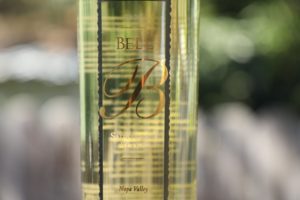 Their first wine, a Chardonnay was later entered into the California State Fair where it won a gold medal. Over the years, production grew to about 10,000 cases a year with wines distributed in California at Safeway, Albertsons and Luckys and in more than 20 states at the height of their operations. Wines they were known for included Chardonnay, Fume Blanc and Cabernet Sauvignon. The Plams also owned 20 acres in St. Helena, planted to vines; grapes from both properties were used in their wines as well as purchased fruit from other Napa Valley vineyards.
Their first wine, a Chardonnay was later entered into the California State Fair where it won a gold medal. Over the years, production grew to about 10,000 cases a year with wines distributed in California at Safeway, Albertsons and Luckys and in more than 20 states at the height of their operations. Wines they were known for included Chardonnay, Fume Blanc and Cabernet Sauvignon. The Plams also owned 20 acres in St. Helena, planted to vines; grapes from both properties were used in their wines as well as purchased fruit from other Napa Valley vineyards.
They produced wines bottled under Plam Vineyards until 2008. After selling this property to Bell Wine Cellars in 1998, Plam Vineyards moved their production to what is now Frank Family Vineyards in Calistoga. Valerie passed in 1995 and Ken remarried to Shirley. The Plams also sold their property in St. Helena and then moved to Solvang on California’s Central Coast. They purchased a 93 acre vineyard, opened a tasting room and sold and promoted wines under the brand, Mission Meadow Winery for four years. Their Solvang tasting room closed in 2004 and they sold their vineyard in 2005 and are no longer involved in the wine business. Serious Plam Vineyards enthusiasts may still be able to purchase older bottles from select online retailers.
—
Vineyards surround Bell Wine Cellars; 6 acres of vines are planted to Chardonnay, Merlot and clone 6 Cabernet Sauvignon. Their Chardonnay and Merlot vines are trellised much higher above the ground then what one normally sees in Napa Valley vineyards. The higher trellising is helpful for keeping the grapes cooler during the heat of the day allowing for ample air flow beneath the higher rows. In addition, the higher vines help keep the grape cluster away from the warmer ground temperatures during daylight hours in the heat of the summer months.
In addition to using grapes from their estate vineyard, Bell Wine Cellars also sources grapes from small family owned growers primarily within Napa Valley but also neighboring counties.
In 2002 Anthony entered into a partnership with former California wine wholesaler Ron Berberian and Alex Spanos (died at age 95 in 2018). Both families have very strong ties to Stockton, CA. The Spanos family are presently majority owners of the Los Angeles Chargers (formerly San Diego Chargers), who play their home games at SoFi Stadium in Los Angeles. Spanos founded A. G. Spanos Companies in 1960; his business would go on to become the largest builder of apartments in the U.S. The family’s primary business is still in real estate development and construction, headquartered in the A.G. Spanos Building in Stockton. And the family has become major philanthropists including a strong presence in Stockton. A.G. Spanos is associated with a number of places and spaces in Stockton.
A.G. Spanos locations, Stockton
- Spanos Park
- A.G. Spanos Companies
- Spanos Business Park
- A.G. Spanos Blvd
SoFi Stadium, Los Angeles
Both Ron and Alex acquired a partial interest in Bell Wine Cellars and purchased the original Plam Cellars and surrounding property. Spanos also used to own a 40 acre vineyard on Pritchard Hill which was developed to vines by winemaker Tom Eddy. Ultimately after Spanos sold this property in 2010, it became the home of Nine Suns Winery, now home to the Realm Houyi Estate.
Both the Berberian and Spanos family are connected through marriage – Alex’s daughter Dea is married to Ron. The Berberian family has been in business in California for decades; the family used to operate a wine and spirits wholesaler in Stockton, CA called Stockton Beverage Co. In 1965 they founded what was the Bank of Agriculture and Commerce, also in Stockton, which was later renamed to BAC Community Bank. As of our latest update to this review, Ron is Chairman and CEO of BAC Community Bank. He also owns the Mercedes-Benz of Stockton dealership on Trinity Parkway.
Bell was active in the Yountville Appellation Association having served as Vice President and Treasurer. He retired from Bell Cellars in 2018 and the last we heard, was living in Florida. His former wife Elaine Bell operated Elaine Bell Catering (originally filed under the name Sonoma Catering Company) until permanently closing the business in 2024. The business employed more than 100 people.
Select Wines
Bell Cellars is long known for hand-crafting balanced and elegant wines. These are wines that show some restraint – are food friendly, age worthy, yet also approachable in their youth. And while their production is focused on primarily Cabernet Sauvignon, they do produce several white wines.
Whites
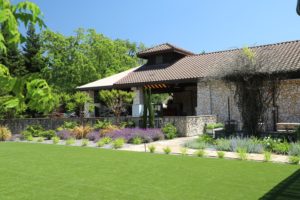
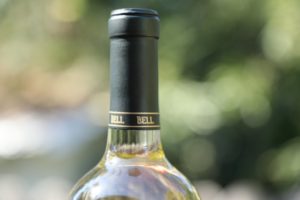
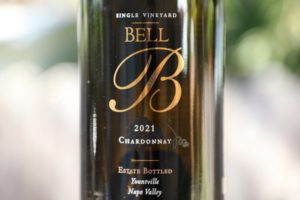 The 2022 Bell Cellars Sauvignon Blanc Napa Valley was partially fermented in oak barrels. It is medium gold in color; the bouquet is vibrant and tends to be more on the fruit forward/tropical side of the aromatic spectrum, as opposed to the green and grassy characteristics that this variety exhibits from cooler sites or from early harvest dates. But with that said, there are also some citrus notes at play. It offers scents of honeysuckle, pineapple, Meyer lemon, mint and passion fruit. The palate reveals flavors of honey crisp apples, mandarin orange, honeydew melon, ripe pomelo, passion fruit, kiwi and white nectarines. The finish is richly fruited and supported by a bright acidity. Juicy and mouth watering, the palate is accompanied by a lightly fleshy mouth feel. We would be quite happy in the company of this bottle paired with fresh Alaskan grilled halibut.
The 2022 Bell Cellars Sauvignon Blanc Napa Valley was partially fermented in oak barrels. It is medium gold in color; the bouquet is vibrant and tends to be more on the fruit forward/tropical side of the aromatic spectrum, as opposed to the green and grassy characteristics that this variety exhibits from cooler sites or from early harvest dates. But with that said, there are also some citrus notes at play. It offers scents of honeysuckle, pineapple, Meyer lemon, mint and passion fruit. The palate reveals flavors of honey crisp apples, mandarin orange, honeydew melon, ripe pomelo, passion fruit, kiwi and white nectarines. The finish is richly fruited and supported by a bright acidity. Juicy and mouth watering, the palate is accompanied by a lightly fleshy mouth feel. We would be quite happy in the company of this bottle paired with fresh Alaskan grilled halibut.
The 2021 Bell Cellars Single Vineyard Yountville Estate Chardonnay was 100% barrel fermented with the wine allowed to go through partial malolactic fermentation. It was then 100% barrel aged for 10 months in 57% new French oak. This wine is deep gold in color; if aromas could be warm California sunshine, this bouquet would be a smart candidate. It offers scents of honeycomb, ripe pineapple, corn tassel, melting butter, banana, lychee, mango and ripe stone fruits including apricot and yellow peach. There is no aromatic shyness here. The palate is rich, sweet and dessert like with flavors of creme Brule, vanilla, apple pie, and ripe stone and tropical fruits including apricot, peach, mango and pineapple. Its texture is lightly creamy. With such a rich and intense flavor profile, the fruit-filled finish is super long-lasting, accompanied by notes of hazelnut/filbert. This wine pairs perfectly with…itself, and doesn’t necessarily need food as an accompaniment.
Reds
The 2019 Bell Cellars Cabernet Franc is 84% Cabernet Franc, 15% Cabernet Sauvignon and 1% Merlot. This wine was aged for 20 months in 100% French oak barrels of which 33% were new. This wine is deep ruby in color; the bouquet is immediately engaging with both floral, fruit and herbal characteristics. It sports scents of jalapeno pepper, dried red chili pepper spice, smoked sage, violets, tobacco spice, Santa Rosa plum and blackberry. Congenial across the palate, there are flavors of blackberry, dark currant and black plum. There are also notes which mirror the bouquet including red chili and tobacco, along with crushed black peppercorns. The tannins are lightly grainy and persist beyond the fruit on the savory and dark finish. A perfect pairing would perhaps be a spicy dry rub seasoned ribeye on the BBQ.
The 2015 Bell Cellars Merlot reveals an elegant bouquet with aromas tending more towards red fruits than darker fruits. The The scents offer a sweetness of fruit including raspberry, dried rose petals and a hint of vanilla as the wine opens further. Smooth and supple on the palate but with plenty of flavor. This wine is seamless with no harsh edges with flavors of red cherry, cranberry and hints of desert spices accompanied by a subtle note of cedar on the finish.
The 2016 Bell Cellars Cabernet Sauvignon Reserve was created from a barrel selection sourced from various vineyard sites throughout Napa Valley. This wine is blended with small percentages of Petit Verdot and Malbec. The bouquet invites one in with aromas of sweet blackberry and raspberry, complemented with a white pepper spiciness, tobacco, darker chocolate and dried rose petals. Aromatically diverse. It is superbly balanced across the palate supported by excellent acidity and flavors of red cherry and currant along with a supple feel of fine-grained tannins.
The 2015 Bell Cellars Clone 7 Cabernet Sauvignon is dark in the glass showing forward aromatics focusing on fruit; these are sweet accompanied by hints of mocha and sage. It sports a wonderful texture, an ethereal lightness if you will across the palate. Seamless in its presentation, the palate offers darker spices and tobacco. Fine-grained tannins with a tender grip are well integrated the supple finish. This is a very approachable wine that is the antithesis of the more up valley, often hillside muscular wines of this variety commonly associated with Napa Valley.
The 2005 Bell Cellars Clone 6 was unfiltered and was sourced from the historic well-known Beckstoffer Georges III Vineyard in Rutherford. The original plantings on site were from 1928 by Georges de Latour (Beaulieu Vineyard). This is a very dark wine with rich concentrated flavors. Cherry, black currant, and blackberry all meld together on the palate anchored by structured tannins on the finish complemented by light notes of pepper and a subtle fling with vanilla; this latter flavor is an influence imparted from the particular French oak barrels it was aged in.
In addition to their Cabernet Sauvignon wines, Bell Cellars produces quite a few other wines including a sparkling wine, a Merlot and a very limited production of a non-vintage Port-style wine; at one point they produced a wine from a vineyard in South Africa. While their vineyard sources are primarily from Napa Valley, they also purchase grapes from vineyards in neighboring counties and other regions in Northern California.
Hospitality
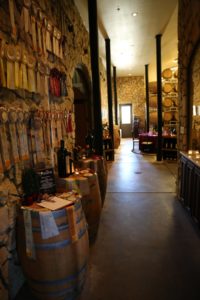
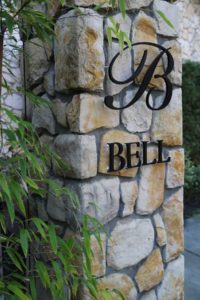 Tastings are by appointment; it is always refreshing discover a winery that caters to guests seeking a more personalized and intimate tasting experience, as opposed to some of the larger and often more crowded wineries along Highway 29 just north of here. Bell Wine Cellars continues to refine their hospitality experiences; as of our latest update to this review they offer Grape to Glass Tour + Tasting featuring a walk-through part of their vineyard with education provided about the vines and the growing season followed by a stop in the cellar and then a tasting of several wines including a barrel sample, Single Vineyard + Single Appellation Cabernet Sauvignon, and their premium offering and what they are most known for, the Single Clone Cabernet Sauvignon tasting, allowing guests the opportunity to sample and discuss wines made from four separate Cabernet Sauvignon clones.
Tastings are by appointment; it is always refreshing discover a winery that caters to guests seeking a more personalized and intimate tasting experience, as opposed to some of the larger and often more crowded wineries along Highway 29 just north of here. Bell Wine Cellars continues to refine their hospitality experiences; as of our latest update to this review they offer Grape to Glass Tour + Tasting featuring a walk-through part of their vineyard with education provided about the vines and the growing season followed by a stop in the cellar and then a tasting of several wines including a barrel sample, Single Vineyard + Single Appellation Cabernet Sauvignon, and their premium offering and what they are most known for, the Single Clone Cabernet Sauvignon tasting, allowing guests the opportunity to sample and discuss wines made from four separate Cabernet Sauvignon clones.
Tastings are held inside the winery next to their barrel rooms or outside weather permitting, next to their pizza oven and bocce ball courts. A tiny Reserve Room is often used for small parties or special tastings.
Their wines have been well received in Japan and Bell Cellars is sometimes popular with Japanese wine aficionados who are seeking a smaller more intimate Napa Valley tasting experience. Some of their wines are nationally distributed while some limited production wines are available through the club or are winery direct only. Total production is around 15,000 cases.
For more information, to schedule an appointment, to purchase wines, to sign up for the mailing list or to join the Classic Wine Club, visit: www.bellwine.com
Winery + Hospitality
Estate Vineyard

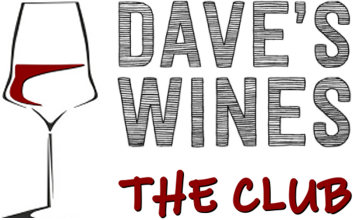




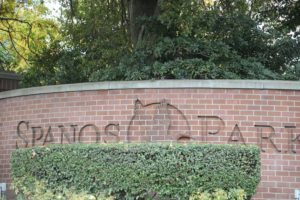
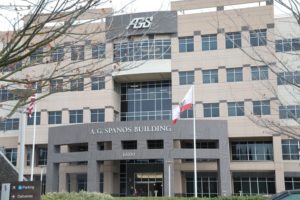
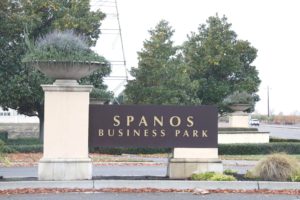
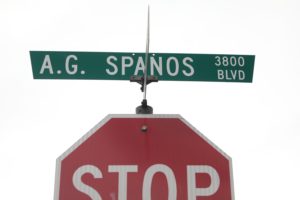
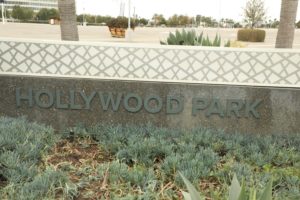

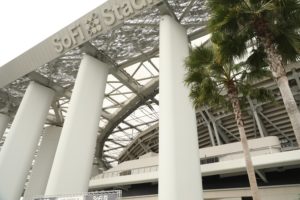

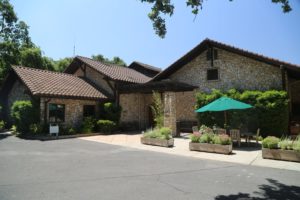
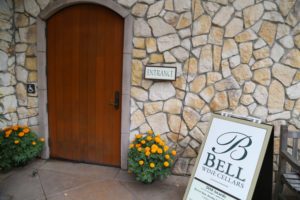
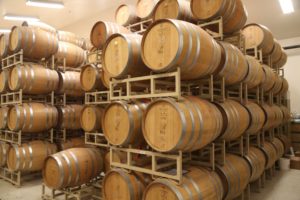
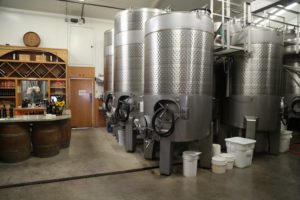
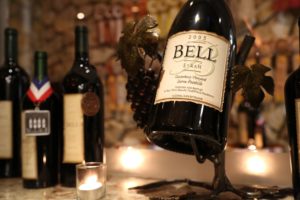

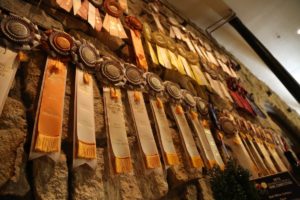
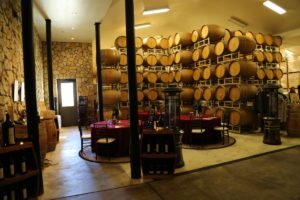
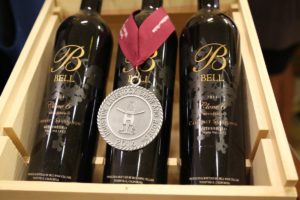
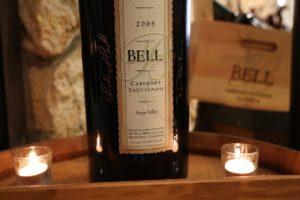
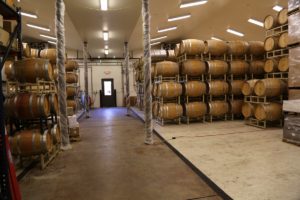
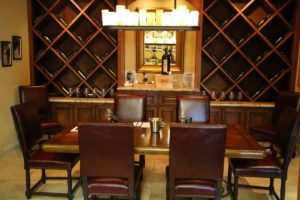
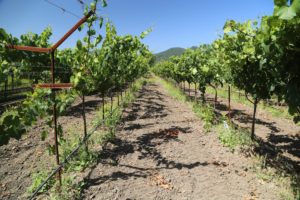
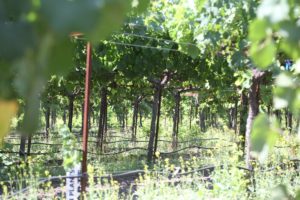
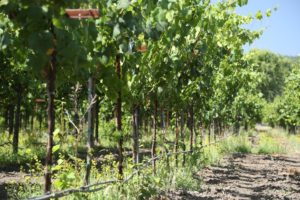
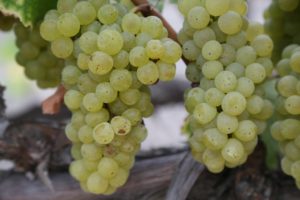
How is the low sulfite experiment going
Hi Barry, we are going to end the experiment. We have a few vintages of no sulfur added to the wines but we don’t see a huge demand for it and we use so little of it in our wines anyway, it is just better to keep doing the best we can in the best manner we know how.
Maggie Bernat, manager at Bell
Barry – if you are interested in more no sulfite added wines (organic) – talk to Kelly Wheat up at Neal Family. He has been playing around with a few barrels recently. Also Mark Bunter of Bunter Spring Winery in Coombsville makes an organic Napa Syrah with no sulfites added.
As Maggie said, there isn’t much demand for it and I rarely come across it in the valley.
~ Dave
Hey guys,
I’m aware the sulphite experiment is no longer needed as I read in the above in the comments. And I fully understand that even if successful, implementing a new system would have been a drastic change on so many levels to the processes you’ve come to know and trust. Which means potential risk to the final product. Don’t mess with success. I get it.
But it was extremely interesting. The fact that you guys were working on a process to eliminate the need for so2 while still protecting the wine is incredible to me. Is there any information available to the public detailing this experiment? I would enjoy reading the research and data from this study. The lack of demand for sulphite free wine does not make it any less innovative. And credit should be given when credit is due. Always impressed,
Andrew
Hi Maggie – this review needs a serious update – not sure how I let this go so long. If you see this, let me know and we can get something scheduled – perhaps one of your Grape to Glass tours 🙂
~ Dave
Hi Dave,
Sorry I just came across your reply! Please come in to see what’s new! just ring us at 707-944-1673 and ask for me!
Maggie – greetings from Thailand at the moment. I will see you April 12th at 1030am if not before. I have an appointment then for the Grapes to Glass with 2 of my friends 🙂
I look forward to meeting.
~ Dave